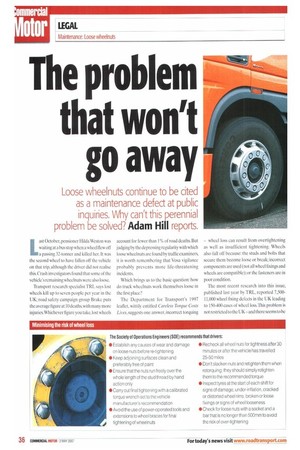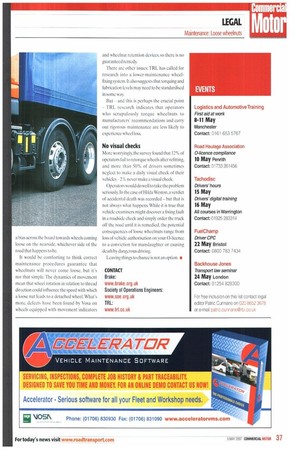The problem that won't go away
Page 36

Page 37

If you've noticed an error in this article please click here to report it so we can fix it.
Loose wheelnuts continue to be cited as a maintenance defect at public inquiries. Why can't this perennial problem be solved? Adam Hill reports.
Last October, pensioner Hilda Weston was waiting at a bus stop when a wheel flew off a passing 32-ton netand killed her. It was the second wheel to have fallen off the vehicle on that trip, although the driver did not realise this. Crash investigators found that some of the vehicle's remaining wheelnuts were also loose.
Transport research specialist TRL says lost wheels kill up to seven people per year in the UK; road safety campaign group Brake puts the average figure at 10 deaths, with many more injuries. Whichever figure you take, lost wheels account for fewer than 1% of road deaths. But judging by the depressing regularity with which loose wheelnuts are found by traffic examiners, it is worth remembering that Vosa vigilance probably prevents more life-threatening incidents.
Which brings us to the basic question: how do truck wheelnuts work themselves loose in the first place?
The Department for Transport's 1997 leaflet, wittily entitled Careless Torque Costs Lives, suggests one answer, incorrect torquing — wheel loss can result from overtightening as well as insufficient tightening. Wheels also fall off because: the studs and bolts that secure them become loose or break; incorrect components are used (not all wheel fixings and wheels are compatible); or the fasteners are in poor condition.
The most recent research into this issue, published last year by TRL, reported 7,50011.000 wheel fixing defects in the UK leading to 150-400 cases of wheel loss. This problem is not restricted to the UK —and there seems toile a bias across the board towards wheels coming loose on the nearside, whichever side of the road that happens to be.
It would be comforting to think correct maintenance procedures guarantee that wheelnuts will never come loose, but it's not that simple. The dynamics of movement mean that wheel rotation in relation to thread direction could influence the speed with which a loose nut leads to a detached wheel. What's more, defects have been found by Vosa on wheels equipped with movement indicators and wheelnut retention devices, so there is no guaranteed remedy.
There are other issues: TRL has called for research into a lower-maintenance wheelfixing system. It also suggests that torquing and lubrication levels may need to be standardised in some way.
But — and this is perhaps the crucial point — TRL research indicates that operators who scrupulously torque wheelnuts to manufacturers' recommendations and carry out rigorous maintenance are less likely to experience wheel loss.
No visual checks More worryingly, the survey found that 12% of operators fail to retorque wheels after refitting, and more than 50% of drivers sometimes neglect to make a daily visual check of their vehicles —2% never make a visual check.
Operators would do well to take the problem seriously. In the case of Hilda Weston, a verdict of accidental death was recorded — but that is not always what happens. While it is true that vehicle examiners might discover a fixing fault in a roadside check and simply order the truck off the road until it is remedied, the potential consequences of loose wheelnuts range from loss of vehicle authorisation on your 0-licence to a conviction for manslaughter or causing death by dangerous driving.
Leaving things to chance is not an option. a
CONTACT Brake: wwvirbrake.org.uk Society of Operations Engineers: www.soe.org.uk TRL: www.trl.co,tik


























































































































































































